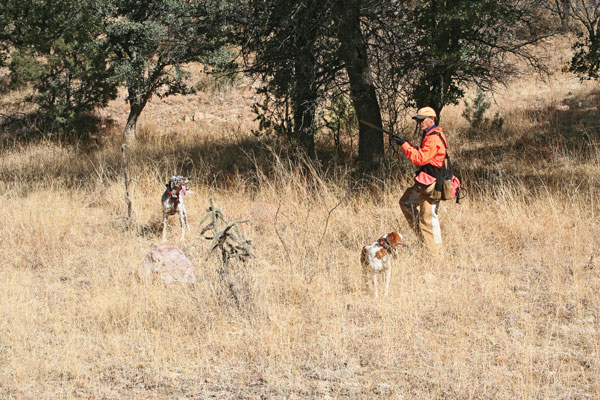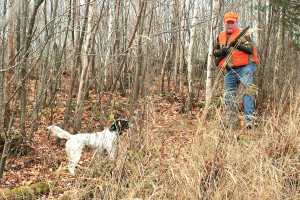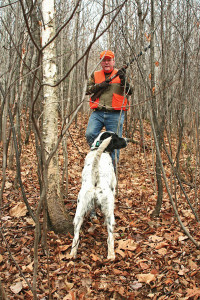 Over the years, I've covered a lot of subjects in this column, mostly focusing on yard work, training that takes place in a controlled environment. It's critical a dog obeys your commands in a controlled environment first, because if he doesn't, putting him into the field later is an exercise in futility. But once you've got that part of his training under control, then what?
Over the years, I've covered a lot of subjects in this column, mostly focusing on yard work, training that takes place in a controlled environment. It's critical a dog obeys your commands in a controlled environment first, because if he doesn't, putting him into the field later is an exercise in futility. But once you've got that part of his training under control, then what?
You take him hunting.
And with that, you open an entirely new perspective on the training process. Thorough yard work is critical, but reinforcing it on an actual hunt is more important still. Dogs don't forget what they've been taught, maybe ever. I've had trainees come back to me several years after graduation from my kennel and within a day or two they're handling as well as the day they left.
So why do so many dogs ignore their owners during the excitement of a real hunt? Simple. Because their owners let them get away with it. Without consistent corrections in the field, most dogs (and I'm tempted to say all dogs) will revert to the level of training that they're comfortable with, which is almost never the level you prefer.
Of course, on a real hunt, it's impossible to catch every infraction. But you don't have to. Catching most of them will get the point across, and the way to do that is to be prepared.
The biggest single reason owners allow their dogs to backslide on a hunt — something that many of them would never consider during a training session — is that their desire to shoot birds takes precedence over their desire to have a well-trained dog. But these aren't mutually exclusive goals. You can and should have both. All it takes is some patience.
Use the Collar
I start the season expecting a newly-trained dog to disobey me when the action begins, and I'm rarely disappointed. In fact, I expect all my dogs to disobey me, newly-trained or otherwise. After a six-month layoff, every one of my little biscuit eaters is looking for an excuse to do things her way, rather than mine, so instead of carrying my gun, which would distract me from the job at hand, I hunt with a friend. He shoots, I marshal the troops.
 That's easy for me to say, you're thinking. Carty hunts 80-plus days a year. He can afford to let someone else shoot. And it's true: I do and I can. (This doesn't earn me a lot of sympathy, but there you go.) Nonetheless, that doesn't change the bottom line: If you don't correct your dog's infractions, he'll infractionate until the cows come home, and the months you spent training over the summer largely will have been wasted.
That's easy for me to say, you're thinking. Carty hunts 80-plus days a year. He can afford to let someone else shoot. And it's true: I do and I can. (This doesn't earn me a lot of sympathy, but there you go.) Nonetheless, that doesn't change the bottom line: If you don't correct your dog's infractions, he'll infractionate until the cows come home, and the months you spent training over the summer largely will have been wasted.
So. If you've trained your dog with a collar, make sure he wears it in the field. I'm amazed that so many people won't take this simple precaution. Collar-trained dogs that handle equally as well without their collars are noteworthy by their absence in the real world.
But more to the point: why wouldn't you use the dog's collar? If your dog has been thoroughly collar conditioned, your risk of making him bird shy with a wrongly timed correction is slim. Use the stimulation level he's become accustomed to during yard work, bump it up a notch or two to compensate for the added excitement inherent in any real hunt, and you should be fine, as long as you adhere to one inviolable rule: Never correct your dog unless you can see him.
If, for instance, your dog enters a patch of willows on the left and a pheasant blows out of that same patch on the right and you know he busted that pheasant, and want to light him up, don't.
Why? Because you didn't see him do it. That means you won't be able to correct everything he does. But as I've already noted, if you correct most of his infractions you'll get the point across. Remember, he already knows what he's supposed to do. What he needs from you is a consistent reminder that what he's supposed to do still applies.
There's a simple drill you can add to the start of any hunt that will focus your dog's attention from the start. Let's say you've trained your dog to heel, whoa, recall to the whistle, and remain steady to flush — a thorough, effective program. At the beginning of the hunt, keep your dog at heel for several minutes, then turn him loose.
As he runs past, give him a whoa command and correct him if he doesn't stop promptly. Release him, and after another minute or two give him a recall whistle, again correcting him if he doesn't promptly respond. That's enough.
You can tailor this drill to whatever it is you've trained your dog to do, but the point is to conduct a short dress rehearsal of what he's learned at the beginning of every hunt. Later, if he's lucky enough to find a bird and point it, you can correct any misbehavior that arises before or after the flush. You won't be tempted to shoot because you won't be carrying your gun. Incidentally, the safest place for you (the trainer) to stand is directly behind the man who is doing the shooting.
Covey Breaks
On-the-job training is an ongoing process, and in one sense it never ends — nor should it. All my dogs are steady to wing, shot and fall. Not because I think that is the most practical way to train a dog, but rather, because that is what I enjoy training my dogs to do. But regardless of how thoroughly they've been schooled, I know that sooner or later each and every one of the four dogs I own will break and chase a departing covey.
 When that happens, I know what to do: I put down my gun, catch my dog, then pick her up and carry her back to the infraction point. That's fair warning, and she'll get only one. If she breaks again, I hit her with a collar correction, and nine times out of 10, that's the end of the problem.
When that happens, I know what to do: I put down my gun, catch my dog, then pick her up and carry her back to the infraction point. That's fair warning, and she'll get only one. If she breaks again, I hit her with a collar correction, and nine times out of 10, that's the end of the problem.
With most dogs, you won't have to focus on maintaining their field work indefinitely. Since I hunt several days a week, it may take only a couple weeks of hunting to get the message across that the dogs' summer obedience lessons still apply. Obviously, that will take longer if you hunt less, and the fewer birds your dog finds, the longer it will take. But the onset of hunting season shouldn't be looked at as the end of a dog's training; it should be seen as the critical last stage in a dog's training progression that reinforces what it already knows.
Only then, when your dog reliably performs what he's been trained to do, will he become a fully-trained gun dog. But when that day arrives, the two of you will experience the very best part of hunting over a finished pointer: teamwork.






